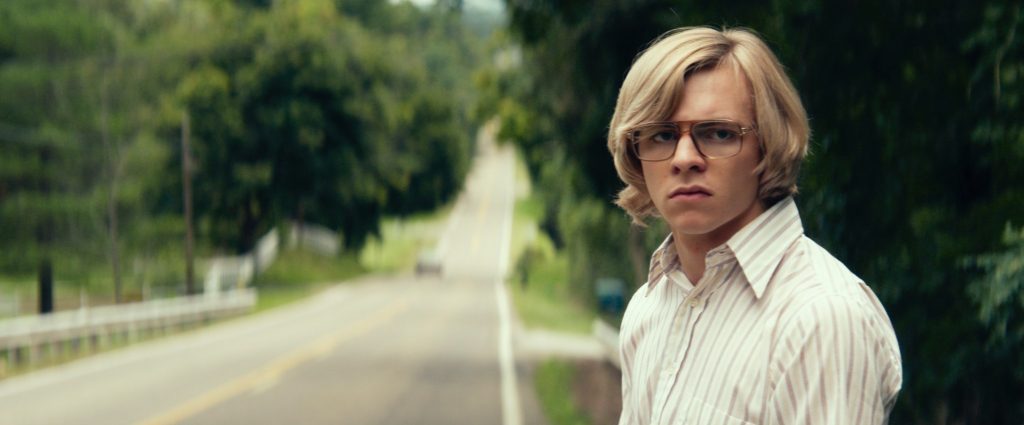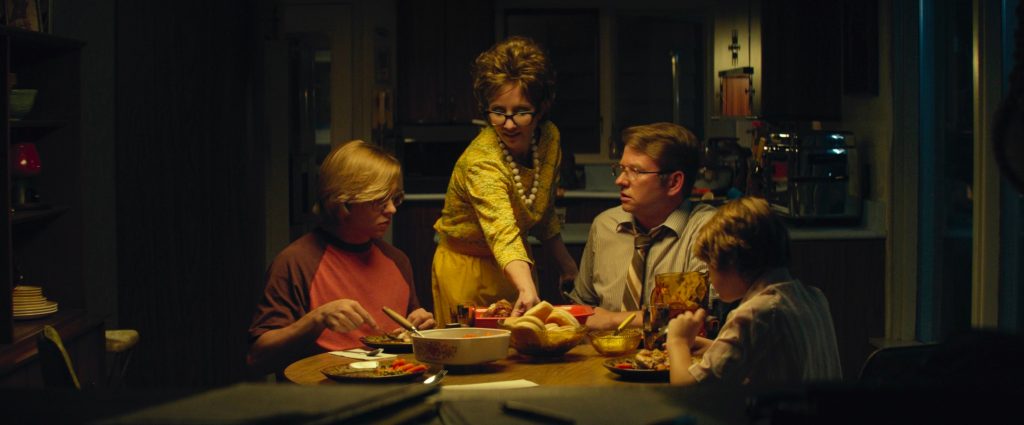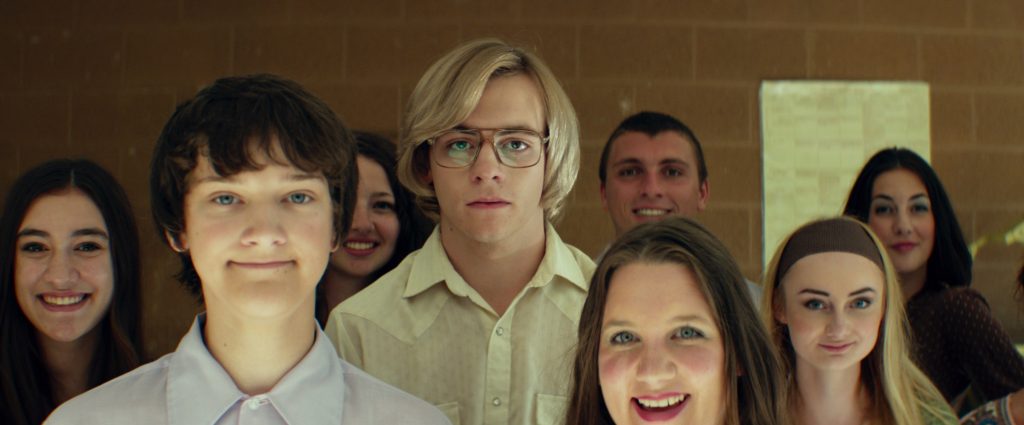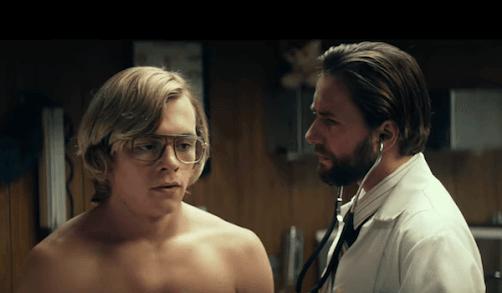
Ross Lynch plays Jeffrey Dahmer in high school. Photo credit: FilmRise
Written and directed by Marc Meyers, My Friend Dahmer is based on the award-winning graphic novel by John “Derf” Backderf, who was a classmate of Jeffrey Dahmer’s in high school. Derf and his buddies adopted Dahmer as a court jester of sorts, calling themselves “the Dahmer fan club.” They coerced the strange young man into participating in pranks while toeing the line between friendship and using him for their own childish entertainment. Disney star Ross Lynch (Austen & Ally) trades in his mouse ears to inhabit the icy, agitated soul of Jeffrey Dahmer and gives a stark, quietly powerful performance.
The closer I examined this film’s story structure, it seemed that My Friend Dahmer is actually a dark, shadow version of Joseph Campbell’s The Hero’s Journey. Turns out that isn’t an accident.
Meyers says, “I was preoccupied with seeing if I could take this story and see how it was relatable to the traditional mythic structure and understand the shape of his journey in relationship to that.”
Let’s go through the story closely and see how it relates to each step in The Hero’s Journey.
SPOILERS AHEAD

Photo courtesy: FilmRise
Protagonist/Antagonist
Despite the evil developing in Dahmer’s soul, Meyers says that Jeffrey Dahmer is definitely the protagonist here. But maybe the antagonist, too.
“I knew he was society’s antagonist, so I was putting myself in the shoes of someone that we didn’t understand. I’m not someone who always creates villains to create conflict. I thought his own depravity made him is own antagonist,” says Meyers.
Other characters in movies with antagonists who are also the villain include Jordan Belfort in The Wolf of Wall Street, Travis Bickle in Taxi Driver and Louis Bloom in Nightcrawler.
No. 1: Ordinary World
High school is the ordinary world where Dahmer is a shy, awkward teen who doesn’t fit in. A loner, he prefers to spend his time in his workshop where he dissects road kill.
“Dahmer was trying to navigate through an ordinary world and remain a teenager but the other side of him was pulling him to darker places,” says Meyers.
No. 2: Call to Action
The call to action in the film takes place when Dahmer’s father Lionel (Dallas Roberts) destroys the workshop, disgusted by the jars of opossum flesh dissolving in acid.
“Dahmer is essentially unleashing his perverted urges to contain these dead animals and now [after the workshop is destroyed] he doesn’t have the hut anymore those impulses are going to go somewhere else, like into town.”
No. 3: Refusal of the Call
His dad destroys the workshop because he doesn’t want his son to become a weirdo. He urges Dahmer to hang out with other kids, but Dahmer argues with his dad, refusing to take his advice.

Photo courtesy: FilmRise
No. 4: Meeting the Mentor
Dahmer is befriended by Derf (Alex Wolff) and several of Derf’s friends at school. While the friendship is lopsided – they laugh at Dahmer more than laughing with him – but belonging to their clique gives Dahmer some confidence. This will be an important tool he’ll need later for bringing men back to his apartment for sex and murder.
No. 5: Crossing the Threshold
When Dahmer has a fake “spaz attack” at school, Derf and his friends think it’s hilarious. At lunch, Derf asks Dahmer to sit with them and the Dahmer fan club is created with the intention of “disrupting the school.” Dahmer finally has a place in school society. It’s a whole new world.
No. 6: Tests, Allies, and Enemies
Dahmer is tested by his new friends in various social environments. As his parents’ marriage crumbles, his family that should be his ally becomes his enemy through their neglect. He puts up with the Dahmer fan club humiliating him because without his workshop and his family, he has nothing else.
“It’s public record that Dahmer’s parents were going though a divorce when he was in high school. My parents also divorced shortly after I got out of high school so that was one of the things I related to and thought I could add some detail to. I took some creative license there but it’s loyal to what the characters were going through,” says Meyers.
No. 7: Approach to the Inmost Cave
The Dahmer fan club asks Dahmer to pull one last prank at the mall where he will humiliate himself. He does it, but fails to earn the glory and affection he seeks from Derf. One member of the group, Neil (Tommy Nelson), is noticeably absent.

Photo courtesy: FilmRise
No. 8: Ordeal
When several of Dahmer’s friends taunt him, saying he’ll never get a date for the upcoming prom, Dahmer sets out to prove them wrong. He asks a freshman girl to his senior prom. At first she says no, but he’s able to convince her that going will be a good way to be introduced to upperclassmen. She agrees to go. Dahmer is learning how to manipulate people to get what he wants. He and his date show up at the prom like any normal students. His friends are in shock.
No. 9: Reward
At the prom, Dahmer’s friend Neil apologizes to him for the way the boys treated him. It is the closest thing to intimacy or true friendship Dahmer experiences.
No. 10: The Road Back
After his mother Joyce (Anne Heche) and his brother go to live at his grandmother’s house and his dad moves in with his new girlfriend, Dahmer now has the entire house to himself, setting the stage for all kinds of potential mischief.
What’s really interesting is that Meyers was able to shoot the film in Dahmer’s actual childhood home. An experience he thinks benefitted the movie.
“I loved it because it was rich in detail. It may seem insane but it’s also honest. It seemed lazy to not try to do the extra work to make that happen. The detail you can accomplish by using his real home and giving that experience to the actors and the crew was really important. I couldn’t find a reason not to,” says Meyers.

Photo courtesy: FilmRise
No. 11: Resurrection
Though it’s not explicit in the movie, it seems that Dahmer has a crush on the confident and charismatic Derf. After Derf gives Dahmer a ride home, Dahmer invites Derf into his house. Reluctantly, Derf agrees to go inside, but is overcome by a creepy feeling and takes off. This angers Dahmer who grabs a baseball bat with the intention of striking Derf as he walks back to his car. This is the moment where Dahmer realizes he’ll never be able to be emotionally and physically intimate with a man the way in which he desires. The proverbial switch is flipped for this anti-hero.
No. 12: Return with the Elixir
Dahmer does so by returning to the ordinary world with a new ability to befriend, manipulate and murder. A dead body is the proof of his journey, of his success. Things will never be the same again.
Typically, films about serial killers end with their capture or death. Audiences like to see order has been restored. But this movie does the opposite. It is a prologue to Dahmer’s killing spree me and could be called a prequel.
Marc Meyers on the Real Jeffrey Dahmer
When I ask Meyers if he has his own personal theory as to what went wrong with Dahmer, he says he’s not a psychiatrist, but a dramatist, offering this theory.
“I can only say that we know he was wired wrong. He was misunderstood by his friends, by his family, by his community – he slipped through the cracks. All the doors that could have prevented him from doing harm were shut in his face. All those that allowed him to descend and devolve into these proclivities that were harmful to him and other people – those doors opened up. It was a mixture of his personal chemistry being off and the situation of the world around him that missed all the signs.”
Despite making a film about a twisted young man that went on to kill, dismember and sometimes eat 17 people, Meyers says surprisingly, Dahmer does not haunt him.
“I don’t reach for the kitchen knives anymore and think that they’re also a weapon.”
My Friend Dahmer opens Nov. 3.




3 Replies to "How to Use the Hero's Journey to write about Jeffrey Dahmer in High School"
Jonathan October 30, 2017 (1:31 pm)
Thanks for this.
Clear, thoughtful, helpful.
A good theory should apply forward and backward.
Converse, Inverse, and Contrapositive should hold up.
And it seems they do.
Jason November 11, 2017 (8:39 pm)
This is my manager’s movie. I’ll send this to him!
Jenna Milly November 12, 2017 (9:59 am)
Fabulous Jason! yay!!